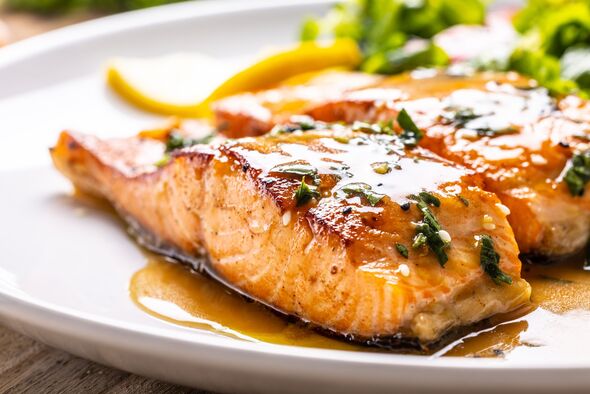Lifestyle
Chefs Reveal Top Techniques for Cooking Perfect Salmon

Cooking salmon is a beloved pastime for many, but achieving the perfect texture and flavor can be elusive. To uncover the best methods for preparing this popular fish, several chefs were consulted. Their unanimous recommendation: pan-frying is the preferred technique for achieving a crispy skin and tender flesh.
Expert Techniques for Pan-Frying Salmon
Ben Chaplin, Head Chef at The Black Friar, a gastropub in Manchester, emphasized the importance of temperature when pan-frying salmon. He advised heating a non-stick pan until it is searing hot before placing the seasoned fillet skin side down. “Let it cook undisturbed for about one minute before lowering the heat slightly and resisting the urge to move or flip it too soon,” Chaplin explained. He noted that when the skin is ready, it will release easily from the pan. The ideal cooking time is approximately three to four minutes on the skin side, followed by a careful flip for another three to four minutes. Allowing the salmon to rest afterwards ensures a slightly pink center that melts in the mouth.
While pan-frying was a common choice among chefs, many also highlighted the value of enhancing salmon with various spices and flavors.
Adding Flavor with Unique Marinades
Judy Joo, founder of the Korean restaurant Seoul Bird, shared her approach to infusing salmon with a spicy twist. She recommends a green chilli glaze, a blend of sweet soy and chilies, which complements the rich flavor of the fish. “The richness of salmon goes brilliantly with the sauce, complemented with a fresh spring onion salad and pickles,” Joo remarked. Her recipe involves whisking together soy sauce, sugar, vinegar, and water, then sautéing garlic and jalapenos before combining them. The final step includes pan-frying the salmon and serving it topped with the glaze.
Sanjay Aggarwal, a cook and author of Spice Kitchen, also favors a spicy approach. He suggests rubbing the salmon fillets with olive oil and a generous spoonful of a favorite spice blend, such as harissa, za’atar, or tandoori masala. Aggarwal advises allowing the fish to reach room temperature before cooking. “Pan-sear the salmon skin-side down until crisp, then finish in a hot oven for tender, flaky flesh,” he said, adding that a squeeze of lemon or lime enhances the final dish.
Mehak Kansal, author and restaurateur behind the Indian restaurant Bindas in London, prefers roasting salmon with a tandoori marinade. She recommends selecting thicker fillets for richer marinades and emphasizes the importance of using fresh salmon over frozen. “I love cooking salmon all times of the year,” Kansal stated. “Choosing fresh allows for better flavor absorption.”
Kansal’s tandoori marinade includes:
– Two salmon fillets
– Two tablespoons cream cheese
– One tablespoon olive oil
– One teaspoon each of garlic purée, ginger purée, tandoori masala, and Kashmiri mirchi powder
– Salt and pepper to taste
– A squeeze of lime
These insights from culinary professionals reveal that while techniques may vary, the shared goal remains the same: to create a deliciously cooked salmon fillet that showcases its natural flavors. Whether pan-frying or roasting, the right method combined with bold marinades results in a satisfying dish that is sure to impress.
-

 Entertainment2 months ago
Entertainment2 months agoIconic 90s TV Show House Hits Market for £1.1 Million
-

 Lifestyle4 months ago
Lifestyle4 months agoMilk Bank Urges Mothers to Donate for Premature Babies’ Health
-

 Sports3 months ago
Sports3 months agoAlessia Russo Signs Long-Term Deal with Arsenal Ahead of WSL Season
-

 Lifestyle4 months ago
Lifestyle4 months agoShoppers Flock to Discounted Neck Pillow on Amazon for Travel Comfort
-

 Politics4 months ago
Politics4 months agoMuseums Body Critiques EHRC Proposals on Gender Facilities
-

 Business4 months ago
Business4 months agoTrump Visits Europe: Business, Politics, or Leisure?
-

 Lifestyle4 months ago
Lifestyle4 months agoJapanese Teen Sorato Shimizu Breaks U18 100m Record in 10 Seconds
-

 Politics4 months ago
Politics4 months agoCouple Shares Inspiring Love Story Defying Height Stereotypes
-

 World4 months ago
World4 months agoAnglian Water Raises Concerns Over Proposed AI Data Centre
-

 Sports4 months ago
Sports4 months agoBournemouth Dominates Everton with 3-0 Victory in Premier League Summer Series
-

 World4 months ago
World4 months agoWreckage of Missing Russian Passenger Plane Discovered in Flames
-

 Lifestyle4 months ago
Lifestyle4 months agoShoppers Rave About Roman’s £42 Midi Dress, Calling It ‘Elegant’









